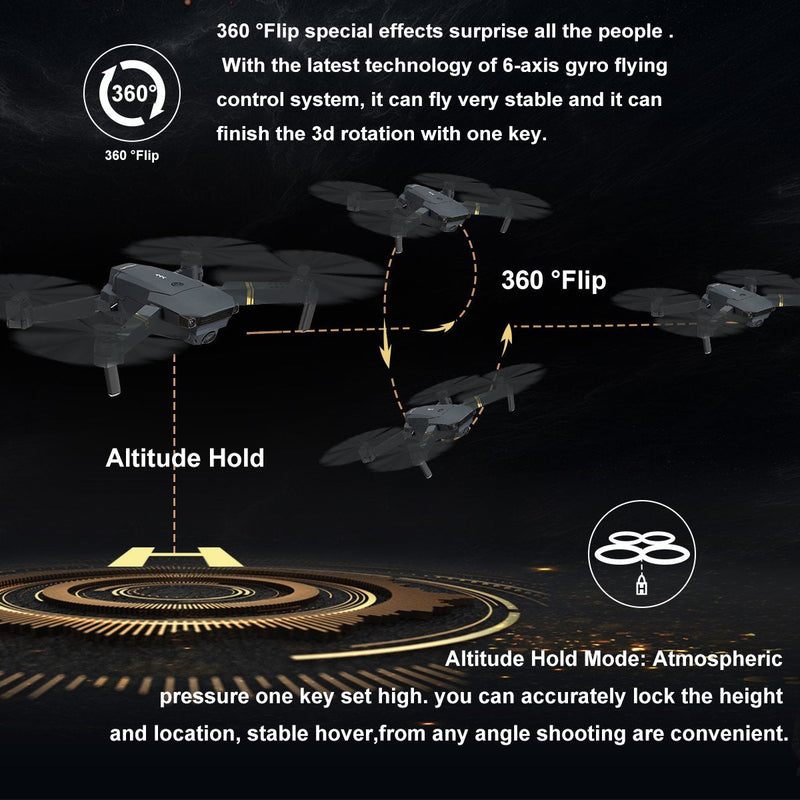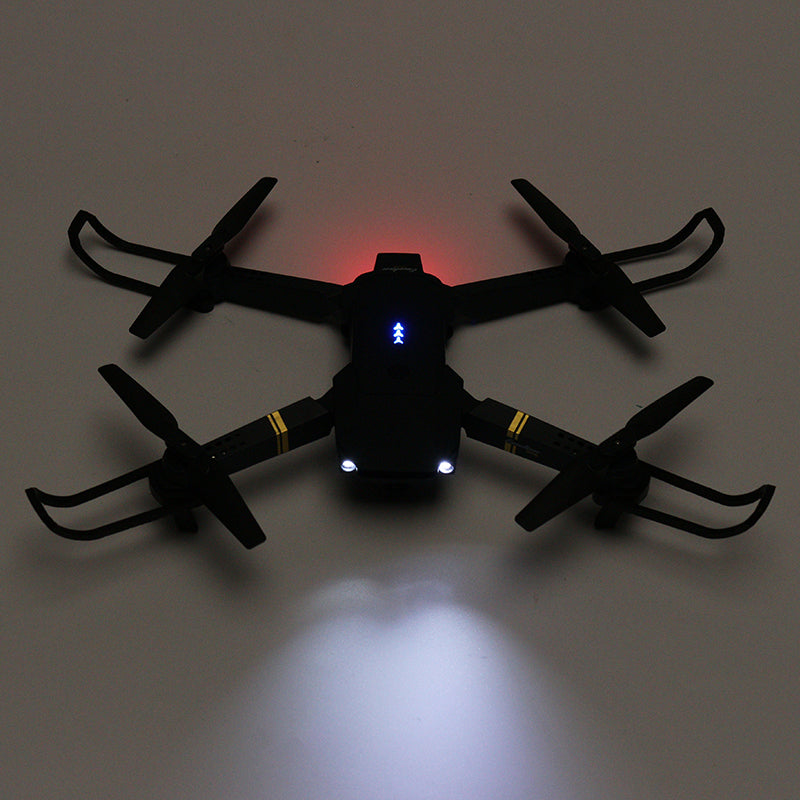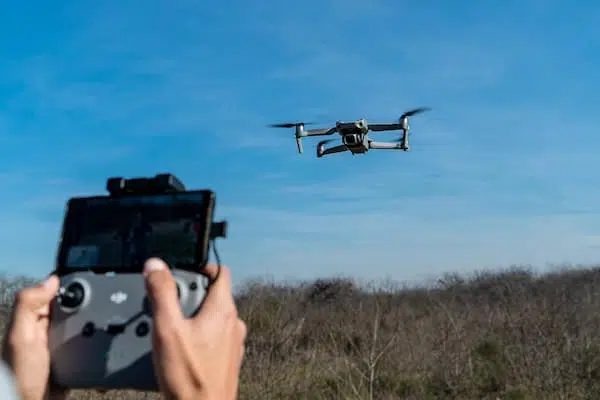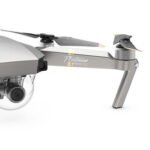Introduction
Overview of the Blackbird 4K Drone
When it comes to aerial photography and videography, the Blackbird 4K Drone has truly carved a name for itself in the drone community. Designed with both hobbyists and professionals in mind, this drone offers an impressive balance of user-friendliness and advanced features. It boasts a stunning 4K camera capable of capturing breathtaking images and videos from angles you never thought possible. 🌟 One of the key highlights of the Blackbird 4K Drone is its sleek design and robust construction. Weighing just enough to give it stability during flight yet lightweight enough for convenient maneuverability, this drone is perfect for those looking to elevate their photography game. With a maximum flight time of around 30 minutes, you can spend more time capturing your vision and less time worrying about battery life. Furthermore, the intuitive mobile app allows you to control the camera settings and view your live feed seamlessly. It comes equipped with various intelligent flight modes. Whether you are targeting a serene landscape or capturing action-packed moments, this drone ensures you get the shots you want with ease.
Benefits of Using the Blackbird 4K Drone
Now that you’ve gotten a glimpse of what the Blackbird 4K Drone is all about, let’s delve into the numerous benefits of using it. From ease of use to enhanced image quality, here’s why many drone enthusiasts are adding the Blackbird 4K to their kit.
- Capture High-Quality Footage: The standout feature of the Blackbird is its 4K camera, which allows for incredibly detailed captures. Whether you are shooting a scenic vista or filming an event, the footage you get is stunning.
- User-Friendly Design: Even if you’re new to drones, the Blackbird provides an easy learning curve. Its user-friendly controls make flying a breeze. You can quickly acclimate to piloting, which means less frustration and more fun!
- Multiple Intelligent Flight Modes: The drone offers a variety of intelligent flight modes such as Follow Me, Waypoint Navigation, and Gesture Control. These features help you focus on your shot without having to concentrate too much on piloting. You can have the drone follow you as you jog through a picturesque landscape, capturing the perfect moments effortlessly.
- Sturdy Build for Durability: Built to withstand the occasional bump or fall, the Blackbird’s construction is solid. This durability means you can take it on outdoor adventures without worrying much about damaging it.
- Long Flight Time: With a flight time of approximately 30 minutes when fully charged, you won’t have to worry about your drone dying mid-capture. This extended time allows you to explore more locations and try out different angles.
- Live Footage Streaming: The ability to stream what you see in real time is a game changer. Utilize the live feed feature for drone racing or to check out locations before deciding where to take shots.
- Affordable Price Point: When compared to other drones with similar features, the Blackbird 4K Drone maintains affordability. You get high-end features without breaking the bank.
- Great Community and Support: Owning a Blackbird comes with the advantage of being part of a passionate community. Whether you’re looking for tips, accessories, or troubleshooting advice, you can easily connect with fellow Blackbird users online.
- Post-Production Flexibility: High-resolution footage offers great flexibility in post-production. You can crop and edit your shots without losing quality, giving content creators a distinct edge.
- Versatility for Various Uses: From real estate professionals shooting properties to filmmakers creating narratives, this drone is adaptable for myriad purposes. Its versatility makes it an excellent investment for creative projects.
With the Blackbird 4K Drone, you’re not just buying a piece of technology; you’re investing in a creative tool that opens up possibilities. Imagine standing atop a hill, capturing the ever-changing colors of the sunset while your drone conducts its aerial ballet. It’s these moments that make owning a drone a rewarding experience. As you embark on your journey with the Blackbird 4K Drone, keep in mind that proficiency comes with practice. Embrace the learning curve, experiment with the different features, and let your creativity soar. Your adventure in aerial photography and videography is just a few flights away! 🎥✈️

Getting Started with the Blackbird 4K Drone
Unboxing and Assembly
Congratulations on becoming the proud owner of a Blackbird 4K Drone! 🥳 The first step in your aerial adventure begins with the unboxing and assembly process. This part is not just about taking items out of the box; it’s about unraveling the potential that lies within each element. As you open the package, take a moment to admire the careful packaging. The Blackbird is typically well-organized, with sections for each component, making it easy for you to find everything. Here’s a handy little checklist of what to expect in the box:
- Blackbird 4K Drone
- Remote Control
- Battery pack (1-2)
- Charger
- Propellers (extra set)
- User manual
- Tool for assembly (if necessary)
Once you’ve located everything, it’s time to put the pieces together. Here’s how to do it:
- Attach the Propellers: Each propeller is designed to fit onto a specific motor, so make sure you’re matching them correctly. Take your time here; ensuring that they’re secure will prevent accidents during your flight.
- Insert the Battery: Slide the battery into the designated compartment until you hear a click. Make sure it fits snugly—loose batteries can lead to unexpected landings!
- Check Connections: Before you fly, double-check all the connections. You want to ensure everything is properly secured and functioning.
- Review the Manual: Take a moment to skim through the user manual. It’s filled with valuable information about the features of your drone and specific assembly tips that can save you from common mistakes.
Once you’ve assembled your drone and admire your handiwork, it’s time for the fun part—figuring out the remote control!
Understanding the Remote Control
The remote control is perhaps one of the most critical parts of your drone setup. Think of it as the bridge between you and the sky. It might seem intimidating at first, but with a bit of practice, you’ll be flying like a pro in no time! First things first, grab your controller and take a look at all the buttons and sticks. It’s usually sensibly laid out, and here’s what you’ll find:
- Left Stick: Typically controls altitude (up and down) and rotation (clockwise and counterclockwise).
- Right Stick: Often manages the drone’s forward and backward movement, as well as lateral navigation (left and right).
- Camera Controls: Depending on the model, you’ll find buttons to start/stop recording, take snapshots, or adjust camera angles. These are essential for capturing those epic shots.
- Gimbal Control: If your Blackbird 4K Drone has a gimbal, you’ll have a separate function to adjust the camera’s tilt, helping you achieve the perfect framing.
A little pro tip: Before heading outdoors, practice indoors. I remember when I got my first drone; I set up some cushions and moved around the house to test all the sticks without any wind interference. It helped me get comfortable with the controls! Here’s a brief breakdown of the main controls you’ll use:
| Control | Function |
|---|---|
| Left Stick Up/Down | Ascend/Descend |
| Left Stick Rotate | Change Orientation |
| Right Stick Forward/Back | Move Away/Toward |
| Right Stick Left/Right | Lateral Movement |
| Camera Button | Capture Image/Video |
Remember to familiarize yourself with the interface of your remote. There might be LED indicators on the controller that show you battery level or signal strength—keeping an eye on these can save you from a sudden surprise during your flight! Lastly, don’t forget to perform a short range test. Turn on your drone and controller, and walk away while maintaining the connection. This little test will allow you to gauge the effective operational range of your Blackbird 4K Drone before you start your first flight. Getting comfortable with your drone’s remote control is the first step toward realizing your aerial aspirations. It allows for a connection that transforms your vision into reality. So, strap in, enjoy the process of learning, and remember to have fun while doing it! After all, every great aerial journey begins with a single flight.🌤️✈️

Mastering Flight Controls
Basic Flight Maneuvers
Now that you’re familiar with assembling your Blackbird 4K Drone and understanding the remote control, it’s time to take to the skies! 🌤️ The thrill of flying can be incredible, especially when you get the hang of it. Let’s dive into some basic flight maneuvers that will set you on the path to becoming a drone pilot extraordinaire.
- Takeoff: Begin by ensuring you’re in an open space free from obstructions. Throttle up by gently pushing the left stick upward. You’ll feel the drone lift off. Keep it steady at a height of around 3-5 feet initially, just to get a feel for how it reacts.
- Landing: To land, gradually lower the left stick until the drone descends smoothly. Be sure to watch the ground and adjust as needed to avoid any rough landings. A tip that worked for me? Try to land in tall grass if you’re still learning; it softens any bumps! 🌱
- Forward and Backward Movement: To move forward, push the right stick up. Pull it down to reverse. Initially, focus on short movements to maintain control. Speed can be tempting, but slow and steady wins the race when you’re still getting the hang of it.
- Lateral Movement: Left or right? You got it—we can do both! Move laterally by pushing the right stick to the side. Again, start small, and you’ll gradually get a feel for how fast your drone responds.
- Yaw: Yawing is simply rotating your drone in place. Use the left stick to turn left or right. This maneuver is essential for framing your shots correctly, especially when capturing panoramic views.
- Hovering: Hovering may seem straightforward, but it’s an art form in itself! Engage your drone’s altitude by maintaining a steady position with your left stick. Use small adjustments to keep it in one spot—this will improve your control significantly.
When practicing these basic maneuvers, don’t forget to keep an eye on the battery life and signal strength. Always land well before the battery runs out!
Advanced Flight Modes
Once you’ve mastered the basics, it’s time to explore some of the advanced flight modes available on your Blackbird 4K Drone. These modes truly enhance your flying experience and can help you capture more dynamic shots. Here are a few worth considering:
- Follow Me Mode: This mode is perfect for action shots or adventure racing. When activated, the drone will autonomously follow you around, capturing every move seamlessly. During my last hiking trip, I used this feature while climbing a hill; it allowed for some breathtaking shots without worrying about piloting!
- Waypoint Navigation: This feature allows you to set specific points on a map for your drone to follow. You can take your hands off the controls, and the drone will navigate the waypoints you predetermined. It’s fantastic for consistent and precise area coverage, especially for capturing landscape footage.
- Circle Mode: As the name suggests, this feature enables your drone to orbit around a designated point while maintaining a steady altitude. This is great for producing stunning shots of a subject while keeping them centered in the frame, no matter where the drone is oriented.
- Return to Home (RTH): Perhaps one of the most crucial features for any pilot, RTH allows your drone to automatically return to its takeoff point. This is especially useful if the battery is low or you lose connection. A little tip: always ensure your home point is accurately set before flying out, just in case!
- Gesture Control: This fun and interactive feature allows you to control the drone using your hand gestures. You can signal for it to take photos or start recording just by waving your hand. It feels like having a magic wand, and it adds a unique touch to your drone experience. 🎉
- Surround Mode: With this mode, you can set the drone to capture a 360-degree view of a scenic location. The drone will perform a circular flight around a specific point, creating captivating panoramic videos.
As you explore these advanced flight modes, always remember to practice in open spaces where you can afford to make mistakes without risk. Experimenting with different settings will not only boost your confidence but also refine your skills continually. Your journey from basic maneuvers to mastering advanced flight modes opens up countless possibilities for creative filming and aerial exploration. Embrace the experience, capture stunning visuals, and most importantly, enjoy it! Your Blackbird 4K Drone is your ticket to seeing the world from a whole new perspective. ✈️📸

Capturing Stunning Aerial Footage
Camera Settings and Features
Now that you’ve mastered the flight controls of your Blackbird 4K Drone, it’s time to harness its incredible camera capabilities to capture stunning aerial footage. 📸 The secret to great visual storytelling lies within understanding your camera settings and utilizing the features your drone offers to their fullest potential.
- Resolution and Frame Rate: Your Blackbird allows you to shoot in various resolutions; however, I highly recommend setting it to 4K for the sharpest quality. For cinematic footage, consider shooting at 24 or 30 frames per second (fps). This mimics the traditional cinematic look that filmmakers love.
Resolution Recommended Frame Rate 4K (3840×2160) 24 or 30 fps 1080p (1920×1080) 60 fps (for smoother action) - White Balance: Setting the right white balance can drastically change the mood of your footage. While auto white balance can work, I often prefer to set it manually according to the light conditions (e.g., sunny, cloudy). This ensures that your colors appear natural and vibrant.
- ISO Settings: Adjust your ISO to control the drone’s sensitivity to light. Keep the ISO low (100-400) in bright conditions to avoid noise, while increasing it in dim conditions, but try to keep it below 1600 for crisp imagery.
- Shutter Speed: A good rule of thumb is to set your shutter speed to double that of your frame rate. For instance, if you’re shooting at 24 fps, aim for a shutter speed of 1/50th of a second. This helps to create a natural motion blur, making your footage more fluid and appealing.
- Picture Profiles: Explore different picture profiles like Standard, Vivid, or Flat. If you’re comfortable with color grading in post-production, using a Flat profile can give you great dynamic range—allowing for more flexibility during editing.
- Gimbal Settings: Be sure to use the drone’s gimbal features to keep your shots steady while in motion. Many drones offer options to fine-tune the gimbal’s responsiveness, ensuring smooth transitions.
- Using ND Filters: Neutral Density (ND) filters can help reduce the amount of light coming into the camera, allowing you to achieve perfect motion blur while using slower shutter speeds. It’s a great way to maintain quality during bright sunny conditions.
Before heading out for your shoot, always take a moment to check and adjust these settings for the conditions you’ll be filming in. Having them dialed in can save you from missing that perfect moment!
Tips for Cinematic Shots
Capturing stunning aerial footage is about more than just optimal camera settings—it’s also about knowing how to frame your shots. Here are some tips I’ve personally found useful to create cinematic magic:
- Establish a Narrative: Before you shoot, think about the story you want to tell. Are you highlighting a landscape, people, or an event? Having a clear purpose will guide your compositions.
- Golden Hour Magic: Take advantage of the golden hour—early morning or late afternoon—when the sunlight is soft and warm. It creates beautiful golden tones and long shadows that add depth to your shots.
- Variety of Angles: Experiment by capturing footage from different altitudes and angles. Low flying shots can highlight the ground and help create a sense of scale, while higher shots give viewers a broader perspective.
- Utilize Slow and Smooth Movements: Sudden jerky movements can ruin footage. Instead, focus on smooth, controlled movements, whether you’re flying in a straight line, circling a subject, or panning to reveal a beautiful vista.
- Incorporate Leading Lines: Use natural lines in the landscape to guide the viewer’s eyes through your footage. This could be a winding road, river, or trail—anything that leads the viewer deeper into the scene.
- Check Your Composition: Remember the rule of thirds! Position your subject off-center to create dynamic compositions. You can overlay the grid lines through the Blackbird app to assist you while flying.
- Short Clips for Impact: For editing later, capture short clips instead of long takes. It’ll make it easier to stitch together engaging sequences without losing the viewer’s attention.
- Practice Breathing Techniques: Sounds funny, but your breathing can affect your hands during flight. Calm, controlled breathing helps you maintain stability with the controls. Just inhale, hold for a second, and exhale to steady your hands before executing your shot.
Before you head out, give yourself time to practice these techniques. The more you shoot, the better you’ll understand how to convey emotion through aerial footage. Each flight is a learning opportunity, and with every outing, you’ll refine your skills—turning those breathtaking moments into beautiful visual stories. Happy flying and filming! 🚁✨

Safety Tips and Regulations
Pre-Flight Safety Checklist
Before launching your Blackbird 4K Drone into the skies, it’s essential to adhere to a pre-flight safety checklist. This not only ensures the safety of your equipment but also promotes responsible flying practices. Think of it as your drone’s very own ritual before it takes off! Here’s a handy checklist you can use each time you prepare for flight:
- Battery Check: Always fully charge both your drone and controller batteries. A good habit is to carry an extra battery if you’re planning a longer session. I vividly remember a time when I got all set for an epic sunset shoot, only to realize my drone battery was down to 10%. 😱
- Firmware Updates: Ensure that your drone’s firmware is up to date. Manufacturers often release updates that enhance functionality and safety. Just check the manufacturer’s app before your flight.
- Inspect the Drone: Conduct a thorough physical inspection of your drone. Check for:
- Propeller damage or wear
- Loose screws or parts
- Cracks or issues with the body
- Gimbal functionality
- Check Weather Conditions: Assess the weather before you fly. Avoid strong winds, rain, or extreme temperatures as they can severely affect flight stability. Using apps for weather forecasts can help you make informed decisions.
- Location Scouting: Before flying, scout your flying location for hazards like trees, buildings, or power lines. Avoid crowded areas and ensure you have enough space for safe takeoff and landing.
- GPS Signal: Make sure your drone has sufficient GPS signal before takeoff. Waiting for a strong GPS lock ensures stability during the flight and helps with RTH (Return to Home) functions.
- Prepare Your Remote Control: Ensure that all the buttons and sticks on your remote are functioning correctly. Check the calibration as necessary to solidify your control and responsiveness during the flight.
- Plan Your Flight Path: Have a flight plan in mind. Knowing where you plan to fly and what shots you want to capture will pave the way for a smooth flight experience.
- Educate Yourself on Emergency Procedures: Familiarize yourself with the emergency procedures, such as how to activate Return to Home or land immediately in case of issues. Being prepared can save your drone and prevent dangerous situations.
By following this checklist, you’re setting yourself up for not just safety but a much more enjoyable flying experience. Being diligent about these steps allows you to focus more on creativity and the joy of flying.
Drone Flying Regulations to Follow
While you dive into aerial adventures, it’s crucial to also be aware of the regulations governing drone usage. Each country and region usually has established guidelines, and understanding them will help you avoid legal trouble—and ensure a safer flying environment for everyone!
- Register Your Drone: In many jurisdictions, drones over a certain weight must be registered with the relevant authority. For instance, in the United States, drones weighing over 0.55 lbs (250 grams) must be registered with the FAA.
- Fly Below 400 Feet: To remain in safe airspace and avoid conflict with manned aircraft, it’s typically advisable not to exceed an altitude of 400 feet. This height keeps you safe and within the legal limits.
- Keep Your Drone in Sight: Always maintain Visual Line of Sight (VLOS) with your drone. If you can’t see it, you might as well be flying blind! This is crucial not just for safety but also to adhere to regulations.
- Respect No-Fly Zones: Be aware of restricted airspace, such as near airports, military bases, and national parks. Most drone apps provide maps highlighting these zones, making it easier for you to plan your flights accordingly.
- Avoid Flying Over People: Flying over crowds can risk public safety, so it’s best to avoid doing so unless you’re working in an authorized area. Many regulations also specify that you should not fly over unprotected individuals.
- Follow Local Noise Regulations: Be mindful of noise ordinances in your area. Drones can be intrusive, and flying in residential zones, especially at night, might aggravate neighbors.
- Insurance and Liability: While not mandatory everywhere, you might consider getting liability insurance for your drone operations. This can protect you from damages in case of accidents.
- Educate Yourself on Local Rules: Always check local laws and regulations before flying your drone. Different places might have unique requirements that you need to be aware of.
Being an informed drone pilot not only allows you to enjoy your flying experience but helps foster a positive community spirit for drone enthusiasts. As you soar through the skies capturing stunning footage, remember to prioritize safety and abide by the regulations! By doing so, you ensure the hobby stays enjoyable and safe for everyone, allowing us to keep our love for drones intact for many years to come. 🚀🛡️

Maintaining Your Blackbird 4K Drone
Cleaning and Care Tips
After you’ve spent a fantastic day capturing stunning aerial footage with your Blackbird 4K Drone, maintenance is key to ensuring it stays in top shape. Just like any tool, proper care can prolong the life of your drone and enhance its performance. So let’s delve into some essential cleaning and care tips to keep your flying companion soaring smoothly! 🌈
- Routine Inspection: After each flight, take a moment to inspect your drone. Look for any visible damage, loose parts, or wear and tear. This routine check can help you address minor issues before they evolve into significant problems.
- Cleaning the Propellers: Dust, dirt, and debris can collect on your propellers over time, affecting flight performance.
- How to Clean: Use a microfiber cloth to wipe down the blades gently. For tougher grime, moisten the cloth with a small amount of isopropyl alcohol.
- Storage Tip: When not in use, it’s a good idea to keep propeller covers on if provided, to prevent scratches and dust accumulation.
- Drone Body Maintenance: The body of your drone can gather dirt and grime, especially if you fly in rugged conditions.
- Cleaning: Use a soft, damp cloth to wipe down the outer casing. Avoid using harsh chemicals or solvent-based cleaners, as they can damage the drone’s materials.
- Camera Lens Care: Your camera is one of the most crucial components, so keeping the lens clean is a must!
- Cleaning Procedure: Use a lens cleaning solution and microfiber cloth to gently clean the lens surface. Always avoid touching the lens with your fingers to prevent smudges.
- Battery Maintenance: Proper care of your drone’s batteries can significantly enhance their lifespan.
- Charging: Always use the recommended charger, and avoid leaving the batteries plugged in for extended periods. Remove the battery once fully charged.
- Storage: For long-term storage, keep batteries at about 50% charge and store them in a cool, dry place.
- Firmware and Software Updates: Regularly updating the firmware ensures you have optimal performance and any bug fixes. Whenever you see an update available, don’t hesitate to download it.
- Transportation: Whenever you’re traveling with your drone, use a dedicated carrying case with ample padding. This protects your drone from bumps during travel, safeguarding it against wear and tears.
Remember, just like you take care of your camera equipment, your drone deserves that same level of attention and love. I always keep a small cleaning kit in my drone bag for quick wipe-downs after flights—trust me, it makes a world of difference!
Troubleshooting Common Issues
Despite all the care in the world, you may encounter some common issues with your Blackbird 4K Drone. While this can be frustrating, don’t fret—there are often simple solutions! Here’s a breakdown of typical problems and how to troubleshoot them:
- Drone Won’t Take Off: If your drone fails to lift off, check the following:
- Ensure that the battery is correctly inserted and fully charged.
- Verify that propellers are securely attached.
- Check for any firmware alerts or error messages on the app.
- Poor GPS Signal: If your drone struggles to connect to GPS, it can lead to unstable flights.
- Solution: Move to an open area away from tall buildings or trees. You may also want to reboot your drone and retry the GPS connection.
- Unresponsive Controls: Sometimes, your drone might not respond to controller inputs.
- Check for Interference: Ensure you’re not flying in an area with strong radio signals that might interfere with your controls.
- Recalibrate the Remote: Follow the calibration process outlined in the manual or app.
- Battery Draining Quickly: If battery life seems shorter than expected:
- Consider the weight of any added accessories you might be using.
- Avoid flying in extreme temperatures; both hot and cold can affect battery performance.
- Video Footage Issues: If you’re experiencing glitches or poor quality in your videos:
- Ensure your camera settings are optimized (see the previous section on camera settings).
- Check the SD card for any problems; formatting it can help eliminate issues.
- Overheating: If your drone is getting hot to the touch:
- Give it time to cool down. Avoid flying in direct sunlight for extended periods.
- Make sure the vents are clear of dirt and debris.
When troubleshooting, remember to stay patient and methodical. It’s easy to panic, especially after investing in your drone, but most of the time, the solution is right at your fingertips. By following these cleaning tips and knowing how to troubleshoot common issues, you can ensure your Blackbird 4K Drone remains in top shape. Maintaining your drone is about more than just keeping it clean; it’s about fostering a long relationship with your aerial companion. With a little love and care, you can keep capturing breathtaking moments for years to come! 🌟✈️



